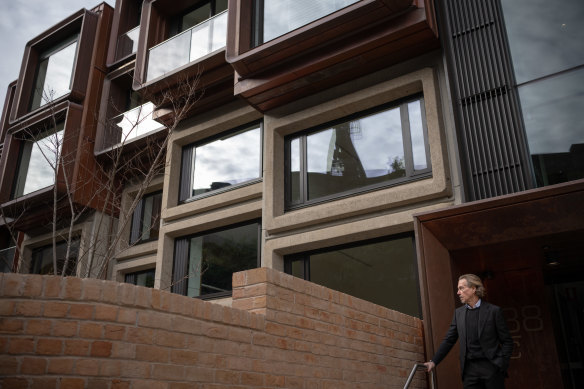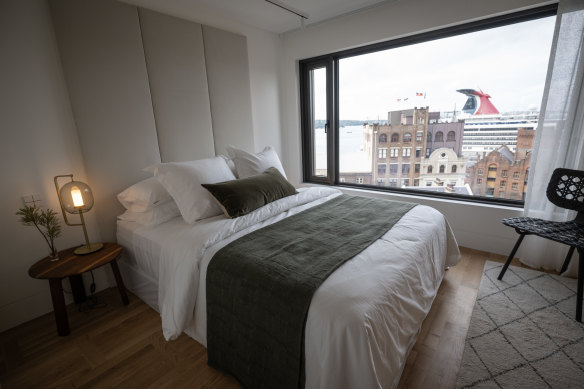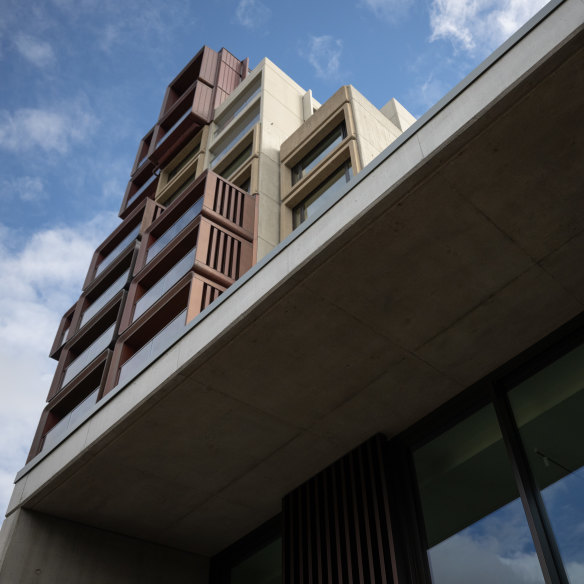The Sirius question: Inside the Sydney building rocking the property conversation
As new owners move in over the next few weeks, the block remains a flashpoint in the debate about public housing in Sydney.
By Julie Power

The redevelopment of the Sirius building is nearing completion. John Green of Dedico, who works for the developer JDH Capital, says some apartments are still available, but many have been snapped up.Credit: Wolter Peeters
When Owen McAloon, a long-standing public housing tenant of the Sirius building in the Rocks, hung the sign “One Way! Jesus!” to block the western sun from turning his unit into an oven, he didn’t expect it to become an icon, visible to any motorist heading into the city.
McAloon later said his sign was designed as a talking point for anyone who saw it: “To get them thinking: ‘What does that mean?’ ”
The conversion of the former housing commission flats into 75 luxury apartments – all sold bar seven apartments – still delivers: It gets people talking.
Developers JDH Capital with architects BVN and Richard Crookes Constructions this week announced the transformation of the Sirius building and the completion of the newly refurbished block after an “ambitious retrofit” that preserved most of the original layout.
They say the brutalist building would have been razed by the former government if they had not saved it by proposing the units be refurbished.
Not far from where McAloon’s sign hung, a 294-square-metre, three-bedroom apartment with marble kitchens and bathroom – with a similar view to his across the Cahill Expressway – sold for about $20 million while the block was still under construction. A one-bedroom 50-square-metre apartment sold recently for $1.7 million.
Still for sale are some two-bedroom apartments between 75 to 95 metres square for between $3.5 million and $6.5 million, and three-bedroom apartments for $13 million to $25 million, said John Green of Dedico, the development director for JDH Capital.
As new owners move in over the next few weeks, the block remains a flashpoint in the debate about public housing in Sydney.

A room with a multimillion-dollar view.Credit: Wolter Peeters
The building is now being marketed as a place where owners can experience a lifestyle like no other. The sales pitch says: “Sirius is a statement of Sydney design, for those who truly understand and value its significance.”
As well as the rough concrete walls and wood designed by architect Tao Gofers in the late 1970s, the Sirius units now have modern interiors. They’re finished with custom parquetry, some echoing the design of its exterior, and marble, including Elba in bathrooms and Arabescato Cervaiole on benchtops.
Copper pods mark where new units have been added, and additions follow the original topography of the building, said architect Phillip Rossington, a principal of BVN.
The total floor space has increased about 27 per cent to 8316 square metres, including a gym, pools, cafes, commercial floor space and other additions.
Two apartments were sacrificed to create a public walkway through the site and provide access to a new public lift to The Rocks’ lower levels, Rossington said.
On the ground floor, the famous Phillip Room where the former tenants gathered to protest their eviction and the sale of the building, has been restored. Its views of the Opera House were only marred on Monday by a cruise ship moored at Circular Quay.
The wood in its vaulted arch roof has been cleaned, and the four bison sculptures that were designed for the space in the 1970s have been restored. Some will be visible to the public from a new public walkway that cuts through the site. The bright ’70s rugs have also been repaired and restored, and will soon be relaid.
NSW Minister for Housing Rose Jackson told The Guardian that selling the Sirius apartments had been a “dud deal” that left us all worse off. She told the Herald that Sydney needed more opportunities for people to live in public housing “everywhere in our city”.
Jackson is now under attack for the government’s decision to sell government-owned land on Parramatta Road, Camperdown to a developer without requiring it to include public (or social) and affordable housing.
On Tuesday, the Australian Institute of Architects questioned whether the NSW government thought “any site” in Sydney was suitable for public housing.

Sirius is on the up and up.Credit: Wolter Peeters
Adam Haddow, the president-elect of the Australian Institute of Architects and the current president in NSW, said the site – close to public transport and a public hospital – seemed perfect for affordable and public housing.
“If not here, then where? We wanted to keep Sirius as public housing, that didn’t happen either because it had harbour views. If the site on Parramatta Road isn’t able to yield affordable housing of 30 per cent, then what is?”
Jackson said the government’s target of 30 per social and affordable housing would be delivered across the entire program. Half of the 500 new homes at Eveleigh would be social and affordable. Kellyville would be a mixed-tenure site. Camden was entirely dedicated to delivering 10 new social homes. Camperdown would have more than 100 private homes.
Start the day with a summary of the day’s most important and interesting stories, analysis and insights. Sign up for our Morning Edition newsletter.